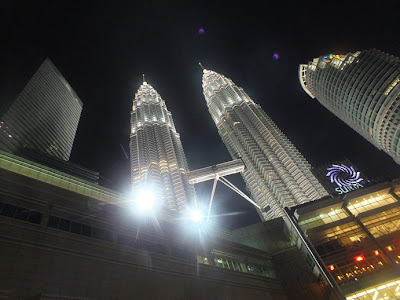So, getting from East Malaysia to West Malaysia by boat didn't work out either. My German couple were ready to take me with them, and even wanted to go to Singapore. But it just didn't seem like it was meant to be as they discovered their boat had a leak and were forced to leave it in Borneo themselves. I'm sure Charley Boorman didn't have these problems when he was filming By Any Means, but then again he has his own BBC film crew and lackeys to organise his itinerary. Kuching was getting boring and 16 days really were enough. I had seen all I wanted to, and had begun to get itchy feet. With a heavy heart I headed down to the airport as soon as I got the bad news and bought myself a ticket to Kuala Lumpur (although, as an aside, I did get to do something that I had dreamt of doing for some time, namely turning up at an airport and just buying my ticket on the spot).
 |
| The famous Petronas Towers which I revisited 7 years after my first trip here. |


